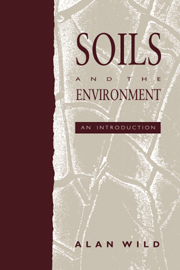Book contents
- Frontmatter
- Contents
- Preface
- Acknowledgements
- Units, symbols and general information
- 1 Introduction: soil in a natural and man-made environment
- A Soil properties and processes
- B Soils in relation to the environment
- 7 Soil as a medium for plant growth
- 8 Soil conditions and crop production
- 9 Soil acidification
- 10 Heavy metals and radionuclides in soil
- 11 Soils, the atmosphere, global warming and ozone depletion
- 12 Soil erosion and conservation
- 13 Soils in the environment: problems and solutions
- Suggestions for further reading
- Index
8 - Soil conditions and crop production
Published online by Cambridge University Press: 06 January 2010
- Frontmatter
- Contents
- Preface
- Acknowledgements
- Units, symbols and general information
- 1 Introduction: soil in a natural and man-made environment
- A Soil properties and processes
- B Soils in relation to the environment
- 7 Soil as a medium for plant growth
- 8 Soil conditions and crop production
- 9 Soil acidification
- 10 Heavy metals and radionuclides in soil
- 11 Soils, the atmosphere, global warming and ozone depletion
- 12 Soil erosion and conservation
- 13 Soils in the environment: problems and solutions
- Suggestions for further reading
- Index
Summary
Introduction
Management of an enterprise in agriculture, horticulture and forestry has to take into account a wide range of issues: the management of soils, crops and animals, the selection and use of machinery and implements, marketing arrangements, man management, and local and world commodity prices. Except for subsistence farming, where security of food supplies is all-important, the purpose is to make the enterprise profitable.
The objective of soil management is to create suitable conditions for the crops that are to be grown. As listed in Section 7.1, soil is required to provide anchorage and the physical and chemical conditions required by the plants. What the farmer does to help meet these requirements depends on what crops he grows, the required yield, the inputs that are available to him and the soil and climatic conditions.
Management of the soil started with the first farmers. Cultivations, rotations and irrigation are ancient practices. In the past 200 years there have been several innovations: farm machinery has become more powerful, crop varieties have been bred that give higher yields, and fertilizers and chemicals for the control of pests have been introduced.
Soil is the growers' main resource and it is in their interests to maintain it in as fertile a condition as possible. In this they are usually successful, but there have been, and still are, examples of bad management. Erosion has been caused by cutting down trees, salts have accumulated in soils under irrigation, and unsuitable soils have been brought into cultivation. Problems such as these, and ways of dealing with them, are dealt with in later chapters.
Information
- Type
- Chapter
- Information
- Soils and the Environment , pp. 137 - 165Publisher: Cambridge University PressPrint publication year: 1993
